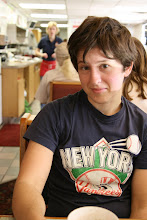 Finished and submitted my application for the CORE residency program in Houston today which, let me tell you, was about as easy as braiding your hair while looking in a mirror. A lot of the text I wound up using comes from various essays I've written over the past year and compiling this compendium of words into a single 800 word essay proved to be most difficult. That being said, here it is!
Finished and submitted my application for the CORE residency program in Houston today which, let me tell you, was about as easy as braiding your hair while looking in a mirror. A lot of the text I wound up using comes from various essays I've written over the past year and compiling this compendium of words into a single 800 word essay proved to be most difficult. That being said, here it is!“What is a ghost?...To most people a ghost is the stuff from which stories are written, the floating, white-clad, luminous form that is seen in deserted houses or in midnight graveyards moaning out messages of terror to the unsuspecting living. To others a ghost is the substance of dreams, appearing at the edge of sleep as the face of a loved one, long gone and almost forgotten, or as the night-mare symbol of all his guilt and his fears... A ghost? Why, a ghost is many things to many people, its nature depending upon the strength of their imaginations.”
-Andrew Tackberry, Famous Ghosts, Phantoms and Poltergeists for the Millions
The English noun, souvenir, comes from the French verb meaning "to remember." But the French verb, souvenir, more literally translates to something like ‘to come from underneath’ which suggests a submersion into the depth of memory and resurfacing in a place of familiarity. It implies a revisitation, not the original experience, but that experience done again. Stories and possessions are souvenirs, evidence of passage through time. But found at a flea market, an object once a souvenir from a particular family narrative becomes a part of a social and phenomenological landscape. By teasing objects and stories out of the singularity of their original possession we can open up the possibilities of belonging/s, where we defy the conventions of autonomy to foster greater notions of collective consciousness. The photograph is one example of a prop that aids us in this shape-shifting process of discovery, essential to defining and then redefining who we are. As Roland Barthes writes in Camera Lucida, “I am the reference of every photograph, and this is what generates my astonishment in addressing myself to the fundamental question: why is it that I am alive here and now?"
I’m interested in objects and histories that speak of the tension between simultaneous absence and presence, as evident in the wear and breakdown of belongings, the fading and reinterpretation of memory and the conflicting truths of contemporary and historical experience. Our memories are clouded with aberrations and apparitions, evidence of their use. This in-between space is a rich place for creativity. Donna Harraway likens it to the diversity of border ecologies, the place where two ecosystems rub up against one another. The mutability of this grayness is as impossible to capture and define as the surface of water, the queer identity, the rendition of a spoken story, and the palpability of haunted atmosphere.
The visitations of memories are ghosts, apparitions from the past which infuse the atmosphere of the present. They lurk about in places, they have messages for the living, they hover above us in the air. They mischievously move things around, they sulk in corners, they visit uninvited, they vanish and reappear. The power of ghosts is in their provocation—this is how they can comprise Tackberry’s “substance of dreams.” In her book Feeling Backward: Loss and the Politics of Queer History, Heather Love writes about the link between utopian longing and fixation with the past, referring to it as “a willingness to be haunted (135).” The willingness of the living to be haunted is akin to nostalgia, the disconnected longing for memories. Both are the hope for that which is lost to be renewed. Karl Marx used this imagery in the opening of The Communist Manifesto when he famously penned: “A spectre is haunting Europe—the spectre of Communism.” Marx aligns the presence of spirit not with the haunting failures of the past but with the incitement of change and revolution.
My studio practice over the past two years have focused on the imagery of domestic interiors in pursuit of the historical narratives built into their arrangement. They have been informed by extensive research into the concepts of ‘longing’ and ‘haunting’ in American history. But how does one render a ghost (“the floating, white-clad, luminous form…the substance of dreams”)? During my residency I propose to focus on the folklore surrounding American hauntings, recording this investigation through writing and the creation of visual works. If the haunting can be understood as a metaphor for memory, then the ghost story provides the script of how to remember. Heather Love affirms the powerful role of storytelling when writing “history—like the future—is a medium for dreaming about the transformation of social life… [T]hey are wild dreams, desires so powerful that they disrupt the linear temporality of progressive history (133).” Founded in the immigrant longing for identity, American hauntings exemplify a longing for belonging to an American dream, a dream as transient as ghost itself.

3 comments:
woah woah, its so weird to come across a perfectly articulated post of what is swirling in my mind right now! This sounds so interesting and exciting, good luck!
Interesting! I want to check out that Heather Love book now. I saw your work at the CCA exhibit yesterday. Really liked all of your pieces. Congrats on a wonderful show! Good luck.
oh mara, i really really love this.
Post a Comment